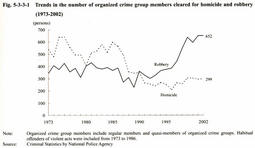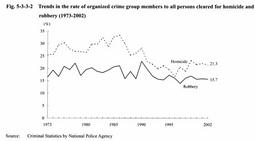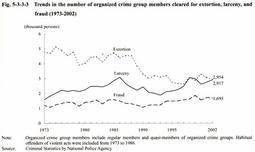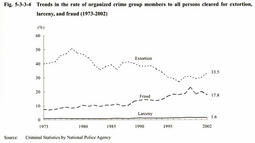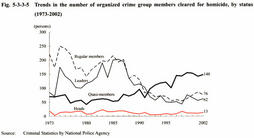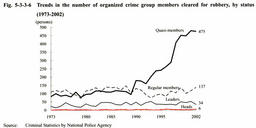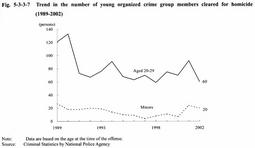| Previous Next Index Image Index Year Selection | |
|
|
1 Changes in Offenders Related to Organized Crime Groups (1) Changes in persons related to organized crime groups and involved in heinous offenses Fig. 5-3-3-1 and Fig. 5-3-3-2 show the number of persons related to organized crime groups and cleared for heinous offenses and the rate of such persons to all persons cleared, by type of offense. From 1973 to 1986, the number of persons related to organized crime groups and cleared for homicide and for robbery remained almost flat with some fluctuation, with the number for homicide having always been larger than the number for robbery. However, the number for homicide moved sideways after dropping sharply in 1991, and it has been increasing slightly since 1997. The number for robbery turned up after declining until 1989, and it has been increasing significantly after it surpassed the number for homicide in 1990. The number for robbery increased 1.8-fold from 1990 to 2002, and it was 2.2 times larger than the number for homicide in 2002. The rate of persons related to organized crime groups and cleared for homicide started to decline after showing a slight upward trend from 1973 to 1986, but it has been moving sideways or rising slightly since 1996. The rate of those cleared for robbery has remained almost flat in the 30 years from 1973, with some fluctuation.
Fig. 5-3-3-1 Trends in the number of organized crime group members cleared for homicide and robbery (1973-2002) Fig. 5-3-3-2 Trends in the rate of organized crime group members to all persons cleared for homicide and robbery (1973-2002) Fig. 5-3-3-3 and Fig 5-3-3-4 show the number of persons related to organized crime groups and cleared for extortion, larceny, and fraud, and the rate of such persons to all persons cleared, by type of offense. The number of persons related to organized crime groups cleared for extortion has been declining after repeatedly fluctuating from 1973 to 1988, decreasing by 38.1% from 1973 to 2002. The number for fraud has been moving almost sideways or rising slightly. The number for larceny declined after rising until 1986, but it has been increasing since 1994, up 37.7% in 2002. On the other hand, the rate of persons related to organized crime groups and cleared for extortion has been on the decline after peaking in 1978, dropping by 17.4 points in 2002 from the peak, whereas the rates for fraud and larceny have been rising from 1973 to 2002, up 10.2 points and 0.7 points respectively.Conventionally, persons related to organized crime groups typically committed homicide and extortion with the support of the organizational power and threats of their groups. However, the numbers of such persons cleared for homicide and extortion have dropped sharply whereas the numbers of those cleared for robbery, fraud, and larceny have been rising. The rates of such persons cleared for homicide and extortion have also dropped sharply whereas the rate for robbery has been moving sideways and the rate for fraud and larceny has been rising. These trends suggest subtle changes in criminal tendencies in persons related to organized crime groups. In this respect, as more stop orders are issued against acts of demanding money or articles under the Anti-Organized Crime Group Law, such illegal acts as well as extortion of the same kind, which caused fear and trouble for the public in the past, may be decreasing. As mentioned above, despite the decrease in the number of those cleared for extortion persons related to organized crime groups are committing various types of offenses by taking advantage of the economic recession, including offenses relating to finance and real estate by which they can make money. In the category of offenses against property, the criminal trend among persons related to organized crime groups seems to be shifting in 2 directions, from cunning extortion backed up by the threat of their related groups to more simple and violent offenses of taking money or articles such as robbery and larceny, and to more advanced intellectual offenses. Fig. 5-3-3-3 Trends in the number of organized crime group members cleared for extortion, larceny, and fraud (1973-2002) Fig. 5-3-3-4 Trends in the rate of organized crime group members to all persons cleared for extortion, larceny, and fraud (1973-2002) (2) Qualitative changes in persons related to organized crime groups and involved in heinous offenses Fig. 5-3-3-5 and Fig. 5-3-3-6 show the trends in the number of persons related to organized crime groups and cleared for heinous offenses, by status in the group. Among those cleared for homicide, the numbers of regular members and leaders fluctuated repeatedly since 1973 and then dropped sharply in 1985 whereas the number of quasi-members has been rising, exceeding the numbers of regular members and leaders in 1992 and continuing to rise since then. Among those cleared for robbery, the number of quasi-members exceeded the number of regular members in 1990 and it has been increasing sharply since then. Thus, quasi-members have accounted for the majority of persons related to organized crime groups who committed heinous offenses, and in particular, a large part of the increase in the number of those cleared for robbery was due to the increase in the number of quasi-members. One of the background factors behind such increase in the number of persons related to organized crime groups, and in particular quasi-members, who were cleared for homicide and robbery may be the fact that, as mentioned in Part 1, Chapter 2, Section 1, organized crime groups tend to be hidden under cover in the society, reducing their numbers of regular members and increasing their numbers of quasi-members under the Anti-Organized Crime Group Law.
Fig. 5-3-3-5 Trends in the number of organized crime group members cleared for homicide, by status (1973-2002) Fig. 5-3-3-6 Trends in the number of organized crime group members cleared for robbery, by status (1973-2002) Fig. 5-3-3-7 and Fig. 5-3-3-8 show the number of young people (aged 14 to 29) related to organized crime groups and cleared for heinous offenses since 1989. As for homicide, the number of minors has been quite small and the number of young people aged 20-29 has not been a few but moving sideways. As for robbery, the numbers of minors and young people have been rising, increasing 1.6-fold and 2.8-fold respectively from 1989 to 2002. This indicates that, among persons related to organized crime groups, minors and young people are involved in robbery cases more frequently.Fig. 5-3-3-7 Trend in the number of young organized crime group members cleared for homicide (1989-2002) Fig. 5-3-3-8 Trend in the number of young organized crime group members cleared for robbery (1989-2002) |
